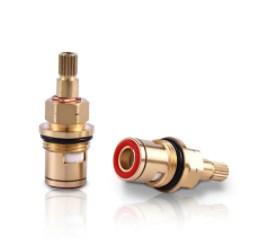Ceramic valve core is pivotal in the operation of various fluid control systems, and its performance in different temperature and pressure environments is a critical consideration for engineers and system designers. These components are often subjected to a range of conditions that can significantly impact their functionality and longevity. This article explores the performance characteristics of ceramic valve cores in various temperature and pressure scenarios, highlighting their advantages and limitations.
The material properties of ceramic valve cores, such as their high hardness, low friction coefficient, and excellent wear resistance, make them suitable for applications where durability and reliability are paramount. However, these properties also need to be evaluated in the context of the environmental conditions they will encounter.
At low temperatures, ceramic valve cores exhibit excellent performance due to their low thermal expansion coefficient. This characteristic ensures that the valve core maintains its dimensional stability, which is crucial for maintaining the seal and preventing leakage. Moreover, the low thermal conductivity of ceramics helps to prevent rapid temperature changes that could lead to thermal shock and potential failure.
As the temperature increases, the performance of ceramic valve cores can be affected. While ceramics have a high melting point and can withstand high temperatures, prolonged exposure to extreme heat can lead to thermal stress and potential deformation. This is particularly relevant in high-pressure applications where the combination of heat and pressure can exacerbate the stress on the valve core. However, the use of advanced ceramic materials and careful design can mitigate these issues and extend the operational range of ceramic valve cores in high-temperature environments.
In high-pressure environments, the strength and rigidity of ceramic valve cores are advantageous. Ceramics can withstand significant pressure without deformation, ensuring that the valve maintains its sealing integrity. This is particularly important in applications such as hydraulic systems, where the valve core must maintain a tight seal under high pressure to prevent leakage and ensure system efficiency.
However, the brittleness of ceramics can be a concern in high-pressure applications. While the material is strong under compressive loads, it is less resistant to tensile and shear forces. This can lead to potential cracking or failure if the valve core is subjected to sudden changes in pressure or if it experiences impact loads. To address this, engineers often incorporate design features such as stress relief grooves and reinforcement to enhance the structural integrity of the ceramic valve core.
Another factor to consider is the chemical compatibility of the ceramic valve core with the fluid it is controlling. Ceramics are generally inert and resistant to chemical attack, making them suitable for use with a wide range of fluids. However, in some cases, the chemical properties of the fluid can interact with the ceramic material, potentially leading to degradation or contamination. It is essential to select the appropriate ceramic material for the specific application to ensure compatibility and maintain the performance of the valve core.
In conclusion, the performance of ceramic valve cores in different temperature and pressure environments is influenced by a variety of factors, including the material properties of the ceramic, the design of the valve core, and the chemical compatibility with the fluid. By understanding these factors and selecting the appropriate ceramic material and design, engineers can optimize the performance of ceramic valve cores in a wide range of applications, ensuring reliable and efficient fluid control.
